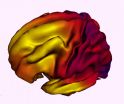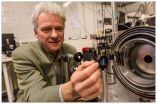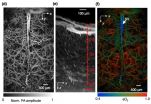(Press-News.org) Characterizing associations between socioeconomic factors and children's brain development, a team including investigators from nine universities across the country reports correlative links between family income and brain structure. Relationships between the brain and family income were strongest in the lowest end of the economic range - suggesting that interventional policies aimed at these children may have the largest societal impact. The study, led by researchers at The Saban Research Institute of Children's Hospital Los Angeles and Columbia University Medical Center, will be published in the early online edition of the journal Nature Neuroscience on March 30.
"While in no way implying that a child's socioeconomic circumstances lead to immutable changes in brain development or cognition, our data suggest that wider access to resources likely afforded by the more affluent may lead to differences in a child's brain structure," said Elizabeth Sowell, PhD, director of the Developmental Cognitive Neuroimaging Laboratory, part of the Institute for the Developing Mind at CHLA. Sowell is also professor of Pediatrics at Keck School of Medicine of the University of Southern California.
In the largest study of its kind to date, the researchers looked at 1,099 typically developing individuals between the ages of 3 and 20 years, part of the multi-site Pediatric Imaging, Neurocognition and Genetics (PING) study. Associations between socioeconomic factors (including parent education and family income) and measurements of surface area of the brain were drawn from demographic and developmental history questionnaires, as well as high-resolution brain MRIs. Statistics - controlled for education, age and genetic ancestry - showed that income was nonlinearly associated with brain surface area, and that income was more strongly associated with the brain than was parental educational attainment.
"Specifically, among children from the lowest-income families, small differences in income were associated with relatively large differences in surface area in a number of regions of the brain associated with skills important for academic success, " said first author Kimberly G. Noble, MD, PhD, assistant professor of pediatrics and director of the Neurocognition, Early Experience and Development (NEED) Lab of Columbia University Medical Center. Noble is also an associate professor of Neuroscience and Education at Teachers College, Columbia University. Conversely, among children from higher-income families, incremental increases in income level were associated with much smaller differences in surface area. Higher income was also associated with better performance in certain cognitive skills - cognitive differences that could be accounted for, in part, by greater brain surface area.
"Family income is linked to factors such as nutrition, health care, schools, play areas and, sometimes, air quality," said Sowell, adding that everything going on in the environment shapes the developing brain. "Future research may address the question of whether changing a child's environment - for instance, through social policies aimed at reducing family poverty - could change the trajectory of brain development and cognition for the better."
INFORMATION:
Additional contributors to the paper include Suzanne M. Houston, MA, and Eric Kan, Children's Hospital Los Angeles and USC; Natalie H. Brito, PhD, Columbia University; Hauke Bartsch, PhD, Joshua M. Kuperman, PhD, Natacha Akshoomoff, PhD, Cinnamon S. Bloss, PhD, Nicholas J. Schork, PhD, Sarah S. Murray, PhD, Anders M. Dale, PhD and Terry L. Jernigan, PhD, UC San Diego; David G. Amaral, PhD, UC Davis; Ondrej Libiger, PhD, MD Revolution; B. J. Casey, PhD, Weill Cornell Medical College; Linda Chang, MD, and Thomas M. Ernst, PhD, University of Hawaii and Queen's Medical Center; Jean A. Frazier, MD, and David N. Kennedy, PhD, University of Massachusetts Medical School; Jeffrey R. Gruen, MD, Yale University School of Medicine; Peter Van Zijl, PhD, Johns Hopkins University School of Medicine; Stewart Mostofsky, MD, Kennedy Krieger Institute; and Walter E. Kaufmann, MD, Boston Children's Hospital; and Tal Kenet, MD, PhD, Harvard University.
Funding for this work was supported by National Institutes of Health grants RC2 DA029475 (NIDA), R01 HD053893, R01 MH087563 and R01 HD061414; and funding from the Annie E. Casey Foundation and the GH Sergievsky Center.
About Children's Hospital Los Angeles
Children's Hospital Los Angeles has been named the best children's hospital on the West Coast and among the top five in the nation for clinical excellence with its selection to the prestigious U.S. News & World Report Honor Roll. Children's Hospital is home to The Saban Research Institute, one of the largest and most productive pediatric research facilities in the United States. Children's Hospital is also one of America's premier teaching hospitals through its affiliation since 1932 with the Keck School of Medicine of the University of Southern California.
For more information, visit CHLA.org. Follow us on our blog http://researchlablog.org/.
Media contact: Debra Kain, dkain@chla.usc.edu
323-361-7628 or 323-361-1812
A new study has confirmed the existence of a positive feedback operating in climate change whereby warming itself may amplify a rise in greenhouse gases resulting in additional warming.
The study, published in the journal Nature Climate Change, shows that in addition to the well understood effect of greenhouse gases on the Earth's temperature, researchers can now confirm directly from ice-core data that the global temperature has a profound effect on atmospheric greenhouse gas concentrations. This means that as the Earth's temperature rises, the positive feedback in the ...
Hamilton, ON (March 30, 2015) - Researchers from McMaster University and the Icahn School of Medicine at Mount Sinai, New York have discovered that a protein associated with neurodegenerative diseases like ALS also plays an important role in the body's natural antiviral response.
The study, published today in Nature Immunology, offers new insight into the link between neurodegenerative disorders and inflammation, and provides a framework to explore more fully the possibility that viral infection may lead to onset of these diseases.
Matthew Miller, an investigator at ...
There are electrical signals in the nervous system, the brain and throughout the human body and there are tiny magnetic fields associated with these signals that could be important for medical science. Researchers from the Niels Bohr Institute have just developed a method that could be used to obtain extremely precise measurements of ultra-small magnetic fields. The results are published in the scientific journal Nature Physics.
The tiny magnetic fields are all the way down on the atomic level. The atoms do not stand still, they revolve around themselves and the axis is ...
Washington, D.C.-- The 2000-2003 drought in the American southwest triggered a widespread die-off of forests around the region. A Carnegie-led team of scientists developed a new modeling tool to explain how and where trembling aspen forests died as a result of this drought. It is based on damage to the individual trees' ability to transport water under water-stressed conditions.
If the same processes and threshold govern the future, their results suggest that more widespread die-offs of aspen forests triggered by climate change are likely by the 2050s. Tree mortality ...
Researchers studying cancer and other invasive diseases rely on high-resolution imaging to see tumors and other activity deep within the body's tissues. Using a new high-speed, high-resolution imaging method, Lihong Wang, PhD, and his team at Washington University in St. Louis were able to see blood flow, blood oxygenation, oxygen metabolism and other functions inside a living mouse brain at faster rates than ever before.
Using photoacoustic microscopy (PAM), a single-wavelength, pulse-width-based technique developed in his lab, Wang, the Gene K. Beare Professor of Biomedical ...
DENVER - Low pre-surgery uptake of a labeled glucose analogue, a marker of metabolic activity, in the primary tumor of patients with stage I non-small cell lung cancer (NSCLC) is associated with increased overall survival and a longer time before tumor recurrence. Patients with high labeled glucose uptake may benefit from additional therapy following surgery.
Surgery is the standard of care for patients with stage I NSCLC but not all patients are cured, as demonstrated by a 5-year survival rate of less than 60% in these patients. There is a clear need for a diagnostic ...
DETROIT - A "perverse disincentive" for hospitals that have invested in expensive technology for robotic surgery may be jeopardizing prostate cancer patients who seek out the procedure, concluded a new study led by Henry Ford Hospital researchers.
The study, which compared complication rates in hospitals with low volumes of robot-assisted radical prostatectomies (RARPs) to institutions with high volumes of the procedure, suggested that current pay-for-performance healthcare models are to blame.
The new study was published online this month by BJU International.
"Patients ...
March 30, 2015 - In women undergoing breast augmentation, a technique using transplantation of a small amount of the patient's own fat cells can produce better cosmetic outcomes, reports a study in the April issue of Plastic and Reconstructive Surgery®, the official medical journal of the American Society of Plastic Surgeons (ASPS).
In particular, the fat grafting technique can achieve a more natural-appearing cleavage--avoiding the "separated breasts" appearance that can occur after breast augmentation, according to the report by Dr. Francisco G. Bravo of Clinica ...
Researchers have shown that a known antibiotic and antifungal compound produced by a soil microbe can inhibit another species of microbe from forming biofilms--microbial mats that frequently are medically harmful--without killing that microbe. The findings may apply to other microbial species, and can herald a plethora of scientific and societal benefits. The research is published online ahead of print on March 30, 2015, in the Journal of Bacteriology, a publication of the American Society for Microbiology. The study will be printed in a special section of the journal ...
From smartphones and tablets to computer monitors and interactive TV screens, electronic displays are everywhere. As the demand for instant, constant communication grows, so too does the urgency for more convenient portable devices -- especially devices, like computer displays, that can be easily rolled up and put away, rather than requiring a flat surface for storage and transportation.
A new Tel Aviv University study, published recently in Nature Nanotechnology, suggests that a novel DNA-peptide structure can be used to produce thin, transparent, and flexible screens. ...




